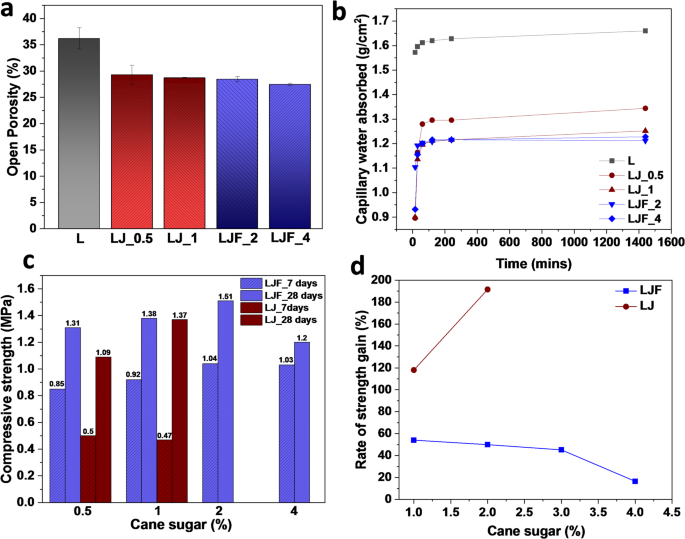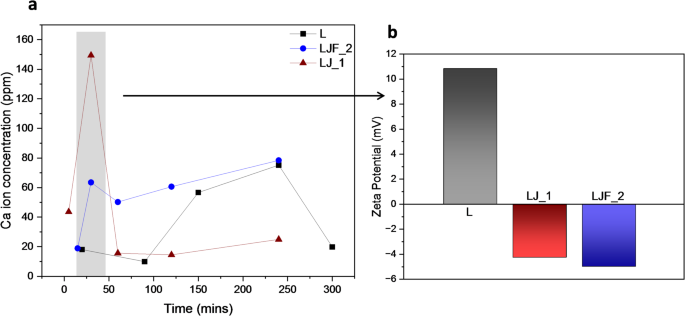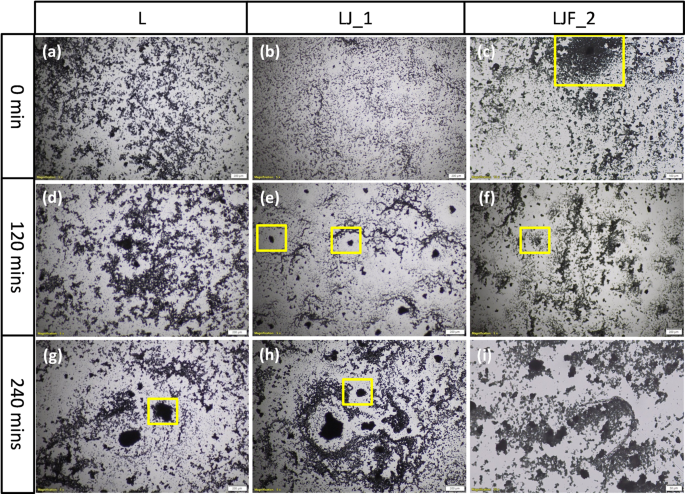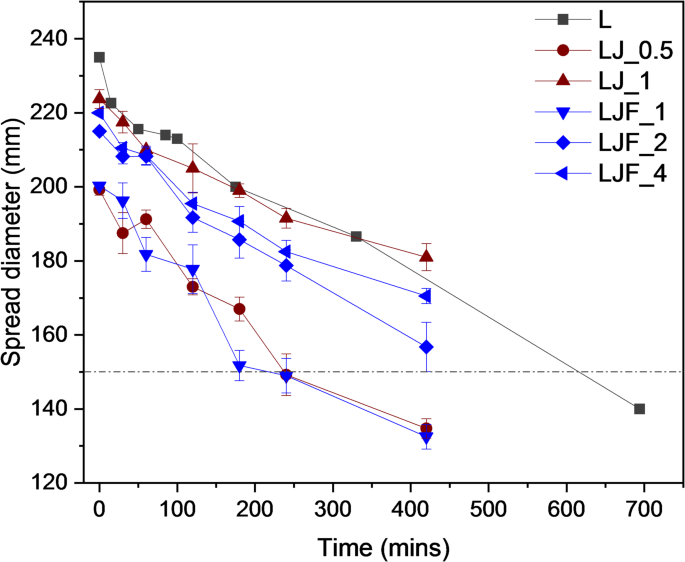Identification of mixtures considered
Dry hydrated air lime of specific gravity 2.37 was used as the main binder material. Crushed stone sand of three different standard sizes was used for the study, mixed in equal proportions. The size ranges were: 2 mm passing and 1 mm retaining, 1 mm passing and 0.5 mm retaining and 0.5 mm passing and 90 μm retaining. The binder to aggregate ratio was followed as 1:3. Table 1 illustrates the mix design followed throughout the work and the respective designations. Pure air lime mortars required a water-to-binder ratio of 1 for adequate workability, while the ratio was reduced to 0.8 for all the other mixtures. The mixtures are designated as L for pure air lime mortar, LJ_0.5, 1–for lime mortars with cane sugar, where J indicates cane sugar and the number indicates the percentage of cane sugar with respect to the water measured. LJF_ 1, 2, 4 indicates the lime mortars with fermented cane sugar, and the number following indicates the fermented cane sugar concentration. The dosages were fixed based on flow and compressive strength properties. With a fixed water-to-binder ratio, the dosages that gave a flow diameter higher than 180 mm were considered. A flow diameter higher than 180 mm is considered to be in a moderate workable range29. The dosage was limited to 1% in non-fermented, as the mixture started bleeding with higher dosages. A compressive strength drop was observed after 28 days when fermented cane sugar was added to lime mortars beyond 4%. The excessive delay in carbonation might be hindering the strength gain; hence the concentration was limited to 4%. Commercially available cane sugar of total sugar content around 99% was added without any processing for non-fermented additions. To ferment cane sugar, the measured jaggery was mixed with water and kept in closed containers in a curing room where a temperature of around 25 °C and a high relative humidity of 99% is maintained. The solution is stored in this room, preferably for 3–4 days. The prepared solution was used to mix mortar instead of mixing normal water.
Workability and retention with time
In this section, flowability and retention time are studied as the two major but distinct parameters of workability, whose requirement for mortars varies with the application. Assessing the flowability of developed mixtures for plasters and mortars are important for its application. The parameter gives an idea on the workability and plasticity properties of mortars. Fermented and non-fermented cane sugar was used in ancient times and determining the flow diameter and retention with respect to time will directly link to the difference in performance based on workability. Figure 1 illustrates the change in flow diameter of different mixtures with respect to time. Pure air lime mortars had higher flow diameters attributed to the higher water content in the mixture. The water-to-binder ratio of pure air lime mortars was brought down from 1 to 0.8, for cane sugar blended mortars. As per studies done formerly in the laboratory, a mixture is classified as high, moderate and less workable when flow diameter is above 230 mm, between 180 and 230 mm; between 150 and 180 mm. A lime based mixture loses its workability when flow diameter goes below 150 mm. Addition of 1% of cane sugar in non-fermented form attributed to a very high workable range, above 200 mm flow diameter just after mixing. A moderate workability range was maintained by LJ_1 for around 6 h. By reducing the cane sugar content from 1 to 0.5%, the mixture remained in moderate workability until 1.5 h and then remained in a low workable region until 4 h. Cane sugar content was limited to 1%, as further addition caused bleeding of mixtures.
Influence of different forms of cane sugar on workability and retention with time. Red and blue coloured lines illustrate the variation for non-fermented and fermented cane sugar addition respectively in air lime mortars. A dashed line at 150 mm (Y-axis) is an indication on the workability loss of mortars.
LJF_1 and LJ_0.5 showed a very similar behaviour in terms of flow diameter retention ranges. Both the mixtures lost its workability in 4 h after mixing. With higher fermented cane sugar content in the mixing water (2%), the flowability was improved when compared to LJF_1. The mixture reached a low workable stage in around 4 h and lost its workability in 6 h. The flow properties were improved further with 4% fermented solution in lime mortars. However, their influence on long-term age properties needs to be assessed to optimise the concentration. Therefore, it is concluded that for higher workability retention, particularly more than 4 h, cane sugar has to be added in non-fermented form and for a reduced retention time, cane sugar has to be added in fermented form.
Variation in physical and mechanical properties with age and concentration of cane sugar
Open porosity and capillary water absorption provide an awareness of the physical porosity and permeability characteristics of lime mortars blended with organics. Figure 2a illustrates the open porosity of various mixtures considered.

Physical and mechanical properties of cane sugar modified lime mortars (a) Open porosity variation in mixtures with fermented (blue) and non-fermented (red) cane sugar; (b) Capillary water absorbed by mixtures; (c) Compressive strength of mixtures after 7 and 28 days of natural carbonation for mixtures with different concentrations of cane sugar in fermented and non-fermented state; (d) Rate of strength gain variation in percentage with fermented and non-fermented cane sugar addition.
Pure air lime mortars exhibited the highest open porosity of 36% after 28 days of natural carbonation. With cane sugar addition, the open porosity dropped to around 30% and with an increase in the organic content, the open porosity seemed to reduce further. A similar effect was observed with fermented cane sugar addition as well. With higher concentration, the porosity tends to drop. The reduction in open pores is also reflected in the capillary water absorption. Mortars act as sacrificial agents in a masonry structure; hence, it is suggested to have higher water absorption when compared to the substrate. Figure 2b illustrates the capillary water absorption of mortars after 28 days of natural carbonation with time. All the developed mortars reached capillary saturation in 30 min. Air lime mortars absorbed the highest amount of water, thus agreeing with the highest open porosity. With cane sugar addition, the absorption was reduced and significantly reduced with fermented cane sugar addition, likely because of the enhanced carbonation. This indicates that the pore distribution may also vary with the form of cane sugar used. Therefore, the amount of cane sugar has to be limited to the prescribed numbers, as increasing the dosage is observed to block the pores that might lead to lesser breathability and hence incompatibility. Often, for heritage structure repairs, cane sugar is added without any upper or lower limit on the dosage. A lesser quantity of cane sugar might not contribute to workability retention or act as a water reducer, while a higher quantity is observed to bleed the mixture and block the pores. Hence, optimising the content of cane sugar in lime works is important to avoid negative responses. The compressive strength of lime mortar with fermented jaggery (LJF) and with non-fermented jaggery (LJ) after 7- and 28-days curing is shown in Fig. 2c.
The strength of LJF samples shows an increasing trend with an increase in jaggery content (i.e., from 0.5 to 2%) and exhibits a reduction in strength by 20.5% with an increase in jaggery content from 2 to 4% after 28 days of curing. The LJF_0.5 samples also show a distinct increase in strength from 0.85 to 1.31 MPa with an increase in the curing period from 7 to 28 days; however, the rate of strength gain shows a decreasing trend with an increase in fermented jaggery content as depicted in Fig. 2d. A significant strength increase from 0.5 to 1.09 MPa was observed for LJ_0.5 specimens. The 28 days strength of LJ specimens increased from 1.09 to 1.37 MPa by increasing cane sugar content from 0.5 to 1%. The 28 days strength increased marginally from 1.31 to 1.38 MPa with an increase in fermented cane sugar content from 0.5 to 1%; however, a higher change was observed with 2% dosage. The strength dropped to 1.2 MPa with 4% fermented cane sugar addition, attributed to the very high poisoning of Ca2+ ion crystals. Strength enhancement is anticipated in longer ages. The LJ samples exhibited strength values lower than LJF in the case of both 7- and 28-days curing, but the rate of strength gain from 7 to 28 days curing was two-fold higher than that observed for LJF samples, corresponding to 0.5% and 1% jaggery content. Fermented specimens attained over 60% of their 28-day strength in 7 days, while less than 50% strength was achieved by non-fermented ones. The difference in the strength gain trend shows the influence of the mode of adding jaggery to lime mortar as a critical parameter. Fermented cane sugar imparted superior early age strength to LJ samples. The increase in strength compared to lime mortar without jaggery is attributed to the reduction in pore size and increase in binding capacity between the particles by the calcium-sucrose adsorption at early ages (i.e., 7 days), followed by the influence of carbonation with an increase in curing period30.
Action mechanism of organics in lime system
The dissolution of Ca2+ ions and the availability of CO2 near the system completely control the reaction kinetics of air lime mortars. To flag off the reaction, an initial dissolution of Ca2+ ions in the pore solution is important. The pore solution is collected to assess the extent of ion dissolution and the effect of the retarder with respect to time31. The pore solution composition of the binder at early stages determines the stable phases, reaction kinetics and precipitates formed32. The study is limited to the early stage to comprehend the reaction kinetics and ion dissolutions occurring with the addition of the retarder. The concentration of Ca2+ ions in the pore solution is determined from the pore solution tested with the aid of ICP-AES for the mixtures and plotted against time. The measurements were taken for 4 h, which represents an overall reaction front. Figure 3a illustrates the Ca2+ ion concentration in pure air lime mortars, air lime with 2% fermented cane sugar and air lime mortar with 1% cane sugar. Pure air lime mortars exhibited a very low Ca2+ ion dissolution till the first 100 min after mixing. The ion concentration increased at a later stage and dropped after 4 h of mixing. Contrary to the pattern observed for pure air lime mortars, cane sugar blended lime mortar gave a very high Ca2+ ion concentration after 30 min of mixing32. A similar fashion was seen for fermented cane sugar as well; however, the magnitude of ion concentration was reduced by 62% compared to LJ_1.

Effect of cane sugar in altering pore solution and zeta potential (a) Calcium ion concentration of pore solution extracted from L (black), LJF_2 (blue) and LJ_1 (red) mortars, (b) Samples collected from the shaded region in (a) was diluted to measure the zeta potential. LJF_2 modified the potential significantly, attributed to the higher dosage.
The ion concentration is found to drop after the major peak, indicating calcium ion consumption, possibly due to amorphous calcium carbonate (ACC) precipitation. Not all the Ca2+ ions seem to be participating in carbonation, as a few Ca2+ ions are observed to be in a poisoned state due to the adsorption of sugar molecules onto the surface of the ions. Higher the poisoning effect, higher is the retardation time observed. The higher dissolution rate and dispersion with cane sugar addition for a longer time can be attributed to either electrostatic repulsion or stearic hindrance or both. To comprehend the mechanism more visibly, zeta potential was measured at the point of time when dissolution was higher and ion concentration peaked (Fig. 3b). Portlandite particles showed a zeta potential measuring to 10 mV. This state corresponds to weak electrostatic repulsion between particles and an unstable condition. This state might lead to the flocculation of particles when lime is mixed with water. However, with organic addition, the zeta potential has been modified to a negative measurement. This modification is attributed to the adsorption of organic components onto the portlandite crystals. The surface modification and complex formations lead to a change in zeta potential. The developed zeta potential, irrespective of fermented or non-fermented state, is not enough for a very high electrostatic repulsion. Therefore, the dispersion is owed to the stearic hindrance created by the organic adsorption rather than the electrostatic repulsion. The reduction in the amount of sucrose after fermentation might be leading to lesser retardation.
Optical imaging of the mixtures was done to physically visualise the phenomenon declared. Figure 4 elaborately shows the optical images of the same mixtures just after mixing and after 2 and 4 h of mixing. Figure 4a–c show the particles of L, LJ_1 and LJF_2 just after mixing. Pure air lime mortars shows portlandite crystals bunched throughout the system. With cane sugar addition, the particles seem to be in dispersed state throughout, whereas an initial carbonation with ACC formations is seen with fermented cane sugar addition (highlighted)33,34. Figure 4d–f show the optical images of L, LJ_1 and LJF_2 after 2 h of mixing. Portlandite crystals seem to have clustered in lime mortars, while with cane sugar addition, the dispersion of crystals is seen. Dispersion and reaction progress are observed with fermented sugar addition, indicating a rapid reaction rate when compared to L and LJ_1 mixtures. Figure 4g–i show the reaction progress after 4 h of mixing. Rims of amorphous carbonate are observed around portlandite crystals in pure air lime mortars, indicating very slow initiation of carbonation. LJ_1 system showed some portlandite crystals with carbonates precipitated around them, while some crystals were still poisoned. The fermented cane sugar blended system had most of the portlandite crystals with carbonate precipitation around them.

Optical images of (a), (d) and (g) lime paste samples after 0 120 and 240 min after mixing (box highlighted shows the portlandite particles undergoing slow carbonation); (b), (e) and (h) lime with 1% cane sugar in non-fermented form after 0, 120 and 240 min of mixing (highlighted box shows the poisoned portlandite crystals dispersed in the system); (c), (f) and (i) lime with 2% fermented cane sugar samples after 0, 120 and 240 min of mixing (box highlighted shows the carbonate precipitation immediately after mixing).
Influence of organics in different forms on carbonation of lime mortars
Carbonation is the mechanism governing the setting, strength gain and durability of lime mortars. It is therefore important to address the influence of any additive in lime mortars on carbonation progress. Table 2 shows the portlandite and calcite measured with the help of thermogravimetric analysis in L, LJ_0.5, LJ_1 and LJF_2 after 28 days of natural carbonation. Portlandite dominated lime mortars without any additive after 28 days of curing. Highest carbonation (6.27%) was observed for LJ_0.5 after 28 days, attributed to the lower water content in the system and independent particle dissolution of portlandite crystals. With cane sugar in the system, the surface area available for carbonation increased with independent portlandite carbonation. With higher content of cane sugar in non-fermented form (from 0.5 to 1%), the amount of carbonates was expected to increase, corresponding to the compressive strength results, while a reduction in carbonates was observed.
The increase in strength of LJ_1 after 28 days might be due to the bigger and better developed calcite crystals in the system that is expected with slow carbonation. LJ_1 still has unreacted portlandite crystals higher than LJ_0.5, which indicates slow carbonation with time. With fermented cane sugar addition, the strength and carbonates after 28 days seem to be lower, indicating rapid carbonation at early ages and then slowly growing. The rapid carbonation in the system might have blocked the pores supporting further carbonation, and hence lesser carbonates and higher unreacted portlandite.
